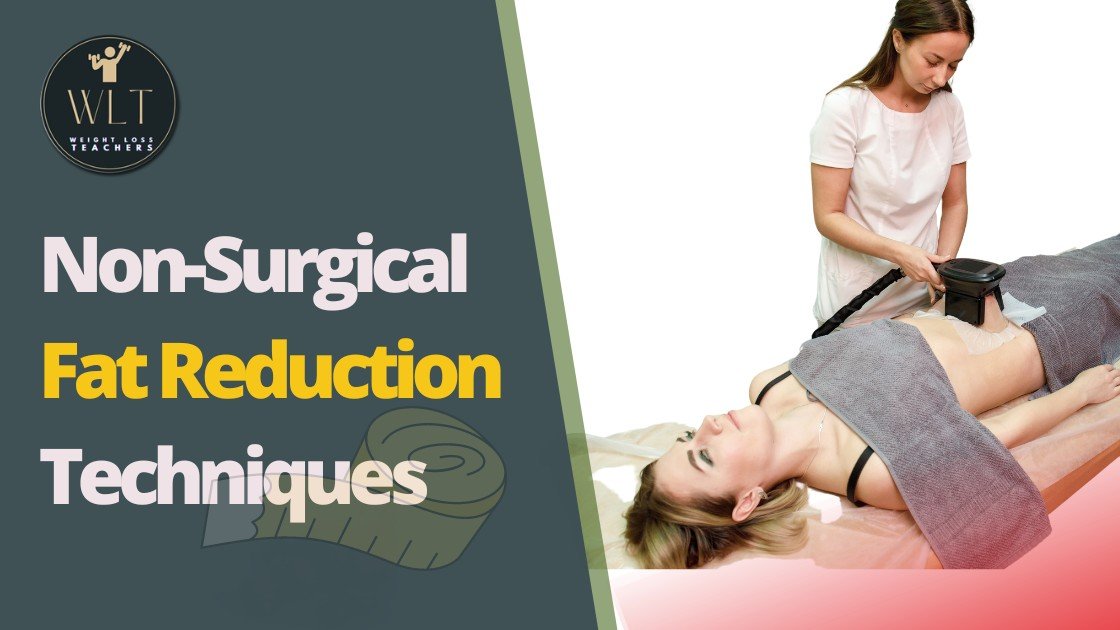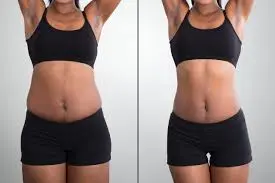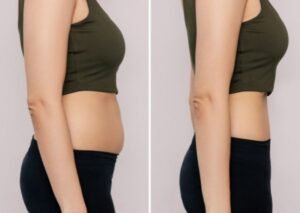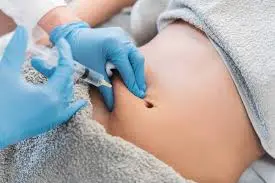
Non-Surgical Fat Reduction Techniques
Are you looking to reduce stubborn fat without undergoing surgery? Non-surgical fat reduction techniques might be the perfect solution for you! These innovative treatments offer effective alternatives to traditional liposuction, with minimal to no downtime.
From cryolipolysis (CoolSculpting) to laser lipolysis (SculpSure) and injectable treatments (Kybella), there are various options to choose from. Discover the benefits, procedures, and what to expect from these non-invasive fat reduction techniques to achieve your desired body contour.
Table of Contents
What is Non-Surgical Fat Reduction?

Non-surgical fat reduction refers to the use of different techniques to eliminate or reduce fat deposits in the body without undergoing surgery. These techniques usually involve the use of energy-based devices such as lasers, radiofrequency, ultrasound, and freezing technologies to break down and destroy fat cells. The body then naturally eliminates the dead fat cells over time.
Unlike surgical procedures, non-surgical fat reduction techniques do not require general anesthesia, incisions, or significant recovery time. Patients can usually return to their normal activities immediately or shortly after treatment.
Types of Non-Surgical Fat Reduction Techniques

Cryolipolysis (CoolSculpting): Cryolipolysis, a groundbreaking non-surgical fat reduction technique popularly known as CoolSculpting, has revolutionized the world of body contouring. This innovative method harnesses the power of controlled cooling to target and eliminate stubborn fat cells, providing patients with a safer and less invasive alternative to traditional surgical procedures. Let’s delve into the science behind this technique and how it achieves remarkable results.
Here’s a summary of the potential benefits of fasting observed within one week, presented in tabular form:
| Benefit | Description |
|---|---|
| Improved Insulin Sensitivity | Fasting can help lower insulin levels and improve insulin sensitivity, which is beneficial for blood sugar control. |
| Weight Loss | Reducing calorie intake and increasing metabolism can result in noticeable weight loss within a week. |
| Enhanced Mental Clarity | Many people report improved focus and mental clarity during fasting periods. |
| Reduced Inflammation | Fasting can decrease inflammation markers, leading to potential reductions in inflammation-related symptoms. |
| Increased Growth Hormone | Fasting can significantly increase the release of growth hormone, important for muscle growth, fat metabolism, and overall health. |
| Boosted Metabolism | Short-term fasting can enhance metabolic rate, helping to burn more calories throughout the day. |
| Improved Digestive Health | Giving the digestive system a break can lead to improvements in digestive function and reduced bloating. |
| Cellular Repair | Fasting triggers autophagy, a process where the body cleans out damaged cells and regenerates new ones. |
| Enhanced Heart Health | Fasting can lead to reductions in blood pressure and cholesterol levels, benefiting cardiovascular health. |
| Reduced Cravings | Fasting can help reset hunger signals, leading to reduced cravings for unhealthy foods. |
These benefits can vary depending on the individual’s health status, the type of fasting, and adherence to the fasting regimen. It’s essential to approach fasting with caution and consult a healthcare provider, especially if you have any underlying health conditions.
At the core of Cryolipolysis lies the principle that fat cells are more sensitive to cold temperatures than surrounding tissues. The procedure begins with the precise application of a cooling device to the targeted area. Over a controlled period, the temperature is lowered to a point where fat cells crystallize while leaving the overlying skin and surrounding tissues unharmed. This controlled cooling induces a natural biological response known as apoptosis, triggering programmed cell death specifically in the targeted fat cells.
Apoptosis, or cellular self-destruction, is a vital process that the body employs to remove damaged or unnecessary cells. Once fat cells undergo apoptosis, they become inactive and are gradually metabolized by the body’s immune system. Over the course of several weeks following the treatment, the damaged fat cells are broken down and eliminated through natural physiological processes, resulting in a gradual reduction in fat volume in the treated area.
The gradual nature of Cryolipolysis is a key factor in producing natural-looking results. Unlike surgical interventions that can lead to sudden changes, the body’s gradual elimination of fat cells through Cryolipolysis ensures that the transformation occurs in harmony with the body’s own processes. This aspect is particularly appealing to patients who seek a subtler, more subtle enhancement of their physique.
Cryolipolysis offers several advantages beyond its fat reduction capabilities. Since the procedure is non-invasive, it eliminates the need for surgical incisions or anesthesia, reducing the associated risks and downtime. Patients can typically return to their daily activities immediately after the treatment, making it a convenient option for individuals with busy lifestyles.
It’s important to note that while Cryolipolysis can provide effective fat reduction, it is not a replacement for a healthy lifestyle. Maintaining a balanced diet and engaging in regular physical activity remain crucial for long-term success. Additionally, individual responses to Cryolipolysis may vary, and multiple sessions might be necessary to achieve optimal results. Consulting with a qualified medical professional is essential to determine if Cryolipolysis is the right option and to develop a personalized treatment plan based on individual goals and needs.
Radiofrequency (RF) Technology: Radiofrequency (RF) technology has emerged as a versatile and effective tool in the realm of non-surgical fat reduction and skin tightening. This innovative approach utilizes controlled radiofrequency energy to target adipose tissue, promoting collagen production, tissue tightening, and fat cell breakdown. Let’s delve into the science behind RF technology and explore how it helps individuals achieve their desired body contours.
RF technology operates on the principle of controlled energy delivery. When applied to the targeted area, the RF device emits electromagnetic waves that penetrate the skin and generate heat within the adipose tissue. This controlled heat has a dual effect: it triggers collagen production while simultaneously disrupting fat cell membranes.
Collagen, a protein found in the skin and connective tissues, plays a crucial role in maintaining skin elasticity and firmness. As we age, collagen production naturally decreases, leading to sagging and laxity. The application of RF energy stimulates fibroblasts, the cells responsible for collagen synthesis, promoting an increase in collagen production. This, in turn, results in firmer, tighter skin over time. The skin tightening effects of RF technology are particularly beneficial in conjunction with fat reduction, as they help prevent sagging and ensure a smoother overall appearance.
Furthermore, the controlled heat generated by RF technology has a direct impact on fat cells. The increase in temperature disrupts the integrity of fat cell membranes, causing them to release their stored contents, primarily composed of fatty acids. Once released, these fatty acids are metabolized by the body’s natural processes, leading to a reduction in fat volume. The combination of collagen stimulation and fat cell breakdown makes RF technology a powerful tool for both body contouring and skin rejuvenation.
RF treatments are often customizable, allowing practitioners to adjust the energy levels based on individual patient needs and treatment goals. Additionally, the non-invasive nature of RF technology eliminates the need for incisions, anesthesia, or significant downtime. Patients can typically resume their daily activities immediately after the procedure, making RF treatments an attractive option for those seeking convenience and effective results.
As with any medical procedure, RF technology does have limitations and considerations. While some patients may see immediate improvements, a series of treatments is usually recommended to achieve optimal results. Individual responses to RF treatments may vary, and a consultation with a qualified medical professional is essential to determine candidacy and develop a personalized treatment plan.
High-Intensity Focused Ultrasound (HIFU): High-Intensity Focused Ultrasound, or HIFU, represents a cutting-edge non-surgical fat reduction technique that utilizes focused ultrasound energy to target and destroy fat cells beneath the skin’s surface. This innovative technology offers precise and controlled fat reduction, making it a sought-after option for individuals looking to sculpt their bodies without undergoing invasive surgical procedures. Let’s delve into the mechanics of HIFU and understand how it achieves remarkable results.
The principle behind HIFU revolves around the controlled delivery of focused ultrasound waves. When these waves are concentrated on a specific target area, they generate thermal coagulation points within the underlying adipose tissue. This thermal effect disrupts the fat cell membranes, initiating a process known as adipocytolysis. During adipocytolysis, fat cells undergo a destabilization and breakage, releasing their stored contents into the surrounding tissue.
Once the fat cells are disrupted, the body’s natural processes come into play. Macrophages, a type of white blood cell responsible for clearing away cellular debris, begin to engulf and eliminate the damaged fat cell remnants. Over the course of several weeks, the body’s lymphatic system processes and eliminates these remnants, resulting in a visible reduction in fat thickness and volume in the treated area.
One of the significant advantages of HIFU is its precision. The technology allows for precise targeting of specific areas, ensuring that surrounding tissues and structures remain unharmed. This precision makes HIFU an excellent option for contouring delicate or hard-to-reach areas of the body.
HIFU treatments offer several benefits beyond fat reduction. The procedure triggers collagen production in the skin, leading to improved skin elasticity and firmness. This dual effect of fat reduction and skin tightening provides patients with a comprehensive solution for achieving their desired body contours.
As with any medical procedure, there are considerations and potential limitations to be aware of. Individual responses to HIFU treatments may vary, and multiple sessions might be necessary to achieve optimal results. It’s important to have a thorough consultation with a qualified medical professional to determine suitability and develop a personalized treatment plan.
The non-invasive nature of HIFU treatments is particularly appealing to individuals who wish to avoid surgery and its associated risks and downtime. Patients can typically resume their regular activities immediately after the procedure, making HIFU a convenient option for those with busy schedules.
Low-Level Laser Therapy (LLLT): Low-Level Laser Therapy, commonly referred to as LLLT or cold laser therapy, has emerged as a unique and non-invasive technique for stimulating fat cells and facilitating their breakdown. This innovative approach employs low-level lasers or light-emitting diodes (LEDs) to target adipose tissue, encouraging the release of fatty acids that are subsequently metabolized by the body. Let’s explore the mechanics of LLLT and understand how it contributes to non-surgical fat reduction.
LLLT operates on the principle that certain wavelengths of light have a specific effect on cells and tissues. When low-level laser or LED devices are applied to the skin, the light energy penetrates the adipose tissue and interacts with the fat cells. This interaction stimulates the fat cells, leading to the creation of tiny pores or openings in their membranes.
The formation of these pores has a significant impact on the fat cells. It triggers the release of stored fatty acids from within the cells into the interstitial fluid, the fluid that surrounds cells. Once released, these fatty acids are transported through the bloodstream to tissues where they can be metabolized and used for energy production.
The body’s natural metabolic processes ensure that these fatty acids are gradually broken down and utilized. This results in a reduction in fat volume in the treated area over time. The gentle and non-invasive nature of LLLT makes it an appealing option for individuals seeking a milder approach to fat reduction and body contouring.
LLLT treatments are often well-tolerated by patients and are associated with minimal discomfort. Patients may experience sensations such as mild tingling or warming during the procedure, but these effects are typically temporary and subside after the treatment session.
One of the advantages of LLLT is its potential for synergistic effects. In addition to its impact on fat cells, LLLT has been suggested to promote blood flow and stimulate collagen production, contributing to improved skin health and appearance. This dual benefit of fat reduction and potential skin rejuvenation makes LLLT a versatile option for individuals seeking comprehensive body contouring solutions.
It’s important to note that while LLLT can provide effective results, individual responses may vary. Multiple treatment sessions are usually recommended to achieve optimal outcomes. Consulting with a qualified medical professional is crucial to determine if LLLT is the right option and to develop a tailored treatment plan based on individual goals and needs.
Injection Lipolysis: Injection Lipolysis, commonly known as “fat-dissolving injections,” has gained prominence as a non-surgical fat reduction technique that offers a localized and targeted approach to contouring specific areas of the body. This innovative procedure involves the injection of a specialized solution into the targeted region to break down fat cells. Let’s delve into the intricacies of Injection Lipolysis and understand how it achieves its remarkable results.
The core principle behind Injection Lipolysis revolves around the use of a carefully formulated solution containing deoxycholic acid. Deoxycholic acid is a natural bile acid that plays a role in emulsifying dietary fat in the digestive process. When introduced into the body through injections, deoxycholic acid acts as a potent fat-cell dissolving agent, effectively breaking down the structure of fat cells.
The procedure is typically performed in a medical setting, where a skilled practitioner precisely injects the solution into the targeted area. Once injected, the deoxycholic acid disrupts the integrity of fat cell membranes, leading to the release of stored fat. This released fat is gradually metabolized and processed by the body’s natural systems, resulting in a reduction in fat volume and a more sculpted appearance.
Injection Lipolysis is commonly used to address small pockets of fat in areas such as the chin and abdomen. The procedure is relatively quick and generally well-tolerated by patients. Discomfort during the treatment is typically minimal, and any mild side effects tend to subside shortly after the procedure.
One of the advantages of Injection Lipolysis is the precision it offers. Practitioners can tailor the treatment to target specific areas with pinpoint accuracy, ensuring that surrounding tissues remain unaffected. This precision makes Injection Lipolysis particularly appealing for individuals seeking targeted fat reduction in localized regions.
Results from Injection Lipolysis may take some time to become fully visible. Patients can expect gradual changes in the treated area over a period of several weeks to months. Multiple treatment sessions may be necessary to achieve optimal results, depending on individual goals and the extent of fat reduction desired.
While Injection Lipolysis offers a non-surgical alternative to fat reduction, it’s important to note that maintaining a healthy lifestyle remains crucial for long-term success. Adhering to a balanced diet and engaging in regular physical activity can help ensure that the results are maintained over time.
Mesotherapy: Mesotherapy, an innovative non-surgical fat reduction technique, has garnered attention for its unique approach to sculpting the body. This procedure involves the injection of a customized solution containing vitamins, minerals, enzymes, and other bioactive compounds into the targeted area. Let’s delve into the intricacies of Mesotherapy and explore how it contributes to effective fat reduction.
At the heart of Mesotherapy is the concept of delivering a tailored blend of nutrients directly into the adipose tissue. The solution often includes phosphatidylcholine, a compound that has the ability to break down fat cells. When introduced into the body through injections, phosphatidylcholine acts as a powerful agent to target and disrupt the fat cell membranes, initiating a process of fat breakdown.
The procedure begins with a consultation with a qualified medical professional who assesses the patient’s goals and designs a customized solution. During the treatment session, the solution is skillfully injected into the targeted area using fine needles. The solution’s bioactive components work synergistically to break down fat cells while promoting improved blood circulation and lymphatic drainage in the treated region.
Mesotherapy is well-suited for treating localized fat deposits in areas such as the chin and abdomen. The procedure is known for its minimal discomfort, and patients can typically resume their regular activities immediately after the session. Over time, the broken-down fat is gradually metabolized by the body and eliminated through natural processes, leading to a reduction in fat volume and an enhanced body contour.
Results from Mesotherapy are not instantaneous and require patience. It may take several weeks for the full effects to become visible as the body processes the released fat and the skin tightens. Due to the gradual nature of fat reduction, multiple treatment sessions are often recommended to achieve the desired outcome.
Mesotherapy’s holistic approach extends beyond fat reduction. The infusion of vitamins, minerals, and other beneficial compounds nourishes the treated area, contributing to improved skin health and appearance. The increased blood flow and lymphatic circulation further aid in the removal of waste products, enhancing overall tissue vitality.
As with any medical procedure, it’s important to have a thorough consultation with a qualified practitioner before undergoing Mesotherapy. This ensures that the treatment is appropriate for individual goals and needs. Additionally, maintaining a healthy lifestyle through proper nutrition and regular exercise is essential for optimizing and sustaining the results achieved through Mesotherapy.
The Benefits of Non-Surgical Fat Reduction

Non-surgical fat reduction techniques have garnered immense popularity for their array of benefits, offering individuals a safe and effective way to achieve their desired body contours without the need for surgical intervention. Let’s delve into the advantages of non-surgical fat reduction methods, highlighting their minimally invasive nature, reduced risk of complications, customizable treatments, gradual results, and minimal downtime.
Minimally Invasive Approach: A Paradigm Shift
Perhaps one of the most compelling aspects of non-surgical fat reduction techniques is their minimally invasive or non-invasive nature. Traditional surgical procedures, such as liposuction, often involve incisions, anesthesia, and a prolonged recovery period. In contrast, non-surgical methods bypass these invasive elements, allowing patients to benefit from fat reduction without the need for surgical intervention. This paradigm shift not only reduces physical trauma to the body but also minimizes associated discomfort, promoting a more comfortable experience for patients.
Mitigating Risks and Complications
Non-surgical fat reduction methods offer a substantial reduction in the risk of complications compared to their surgical counterparts. Surgical procedures inherently carry the potential for infection, scarring, and adverse reactions to anesthesia. Non-surgical techniques, on the other hand, largely eliminate these concerns. By avoiding surgical incisions and anesthesia, patients can enjoy a safer approach to body contouring, particularly individuals who may have underlying health conditions that make surgery a riskier option.
Customization for Personalized Results
One of the remarkable advantages of non-surgical fat reduction treatments is their inherent flexibility and customizability. Each individual’s body is unique, and practitioners can tailor these non-invasive techniques to address specific concerns. Parameters such as energy levels, treatment duration, and applicator sizes can be adjusted to precisely target different areas of the body and accommodate varying degrees of fat accumulation. This personalized approach ensures that patients receive treatments that align with their aesthetic goals and body contours.
“Health is not valued till sickness comes.” – Thomas Fuller
The Grace of Gradual and Natural-Looking Results
Non-surgical fat reduction methods offer a gradual pathway to achieving desired outcomes, promoting natural-looking results that seamlessly integrate with a patient’s overall appearance. This gradual reduction in fat volume allows the skin to adjust and adapt over time, avoiding the abrupt and sometimes jarring transformations associated with surgical procedures. Patients can embrace their evolving appearance as their body responds to the treatment, fostering a sense of confidence and satisfaction.
Minimal Downtime: A Valuable Commodity
In our fast-paced world, time is a precious commodity. Non-surgical fat reduction techniques recognize the importance of minimal downtime, allowing patients to swiftly return to their daily activities after the procedure. Unlike the extended recovery periods often required after surgery, non-surgical treatments enable individuals to resume work, exercise, and social engagements without significant interruption. This convenience is particularly advantageous for those with bustling schedules or demanding lifestyles, offering a seamless integration of body contouring into their routines.
Note: There might be affiliate links mentioned here. We may receive a commission if you purchase a product through an affiliate link. There is no additional charge for you. Please do your own research before making any online purchases.
Considerations before Undergoing Non-Surgical Fat Reduction: Navigating Realities and Choices

Before embarking on a journey towards non-surgical fat reduction, it’s essential to be well-informed and consider a range of factors. Non-surgical techniques offer an enticing path to body contouring, but understanding the nuances and being prepared for certain considerations is crucial. Let’s delve into these important aspects, including having realistic expectations, appropriate candidate selection, the need for multiple sessions, the temporary nature of results, and the sensations that may arise during treatment.
Realistic Expectations: Setting the Foundation
The allure of non-surgical fat reduction lies in its potential to sculpt the body and enhance one’s appearance. However, it’s important for individuals to set realistic expectations from the outset. While these techniques can indeed yield noticeable results, it’s crucial to recognize that the transformation may occur gradually and require patience. Understanding that multiple treatment sessions may be necessary for optimal outcomes is key to embracing the process with a positive mindset.
Candidate Selection: The Art of Suitability
The journey to non-surgical fat reduction begins with appropriate candidate selection. Ideal candidates typically include individuals who are close to their ideal body weight but struggle with localized fat deposits that are resistant to diet and exercise. Consulting a qualified practitioner is vital to assess one’s suitability for the chosen technique. A thorough evaluation ensures that the individual’s goals align with the potential outcomes of the procedure.
Multiple Sessions: A Pathway to Perfection
Non-surgical fat reduction often follows a path of gradual refinement. While some immediate improvements may be observed, it’s important to understand that most techniques require a series of sessions to achieve optimal results. These sessions are typically spaced several weeks apart, allowing the body to respond and adapt to the treatment. Embracing this journey of step-by-step progress is key to reaping the rewards of a sculpted physique.
Temporary Results: Embracing Maintenance
The longevity of results from non-surgical fat reduction techniques can vary based on individual factors, lifestyle, and the specific method used. While these techniques can yield impressive outcomes, it’s important to acknowledge that results may be temporary. Maintenance sessions might be recommended to sustain the effects over time. Embracing a proactive approach to preserving the results can help individuals continue to enjoy the benefits of their chosen procedure.
Treatment Sensation: Navigating the Experience
During non-surgical fat reduction treatments, patients may experience sensations such as tingling, warming, or mild discomfort. It’s important to note that these sensations are usually transient and well-tolerated. The body’s response to the treatment is a sign that the process is underway. After the procedure, any discomfort typically subsides, leaving patients with a sense of accomplishment and anticipation for the gradual transformation that will follow.
Popular Non-Surgical Fat Reduction Technologies: Sculpting with Cutting-Edge Innovation

The realm of non-surgical fat reduction is replete with innovative technologies that empower individuals to sculpt their bodies without the need for invasive procedures. Among these technologies, CoolSculpting, SculpSure, UltraShape, and Vanquish stand out as popular choices, each harnessing unique mechanisms to achieve impressive fat reduction results.
CoolSculpting: The Chill of Precision
CoolSculpting, often regarded as a pioneer in non-surgical fat reduction, continues to hold a prominent place in the field. At its core lies controlled cooling technology, a process that targets specific areas by freezing and crystallizing fat cells. This controlled cooling, also known as cryolipolysis, triggers apoptosis, a natural cell death process. CoolSculpting is particularly effective for addressing stubborn fat deposits in various regions such as the abdomen, flanks, thighs, and even the chin. The procedure’s precision and versatility make it a preferred choice for individuals seeking localized fat reduction.
SculpSure: Laser-Powered Transformation
SculpSure has gained acclaim for its utilization of laser energy to heat and disrupt fat cells. This non-invasive technique targets fat cells beneath the skin’s surface, gradually causing their breakdown. The procedure involves applying laser applicators to the targeted area, where the energy penetrates and raises the temperature of the fat cells. Over time, the treated fat cells are metabolized and eliminated by the body’s natural processes. SculpSure is commonly employed to address fat reduction in areas like the abdomen and love handles, making it a valuable tool for achieving a more contoured physique.
UltraShape: Pulsed Precision
UltraShape distinguishes itself with its innovative use of pulsed ultrasound energy. This technology selectively targets and destroys fat cells while leaving surrounding tissues unharmed. The pulsed ultrasound waves disrupt the integrity of fat cell membranes, initiating a process of fat breakdown. UltraShape is frequently chosen for fat reduction in areas like the abdomen, thighs, and flanks. Its non-invasive nature and precise targeting make it a sought-after option for those seeking effective body sculpting.
Vanquish: The Power of Radiofrequency
Vanquish introduces radiofrequency energy into the realm of non-surgical fat reduction. This contactless treatment method delivers focused radiofrequency energy to large treatment areas, such as the entire abdomen. The radiofrequency energy heats the fat cells, leading to their destruction over time. Vanquish’s unique approach makes it an efficient choice for individuals looking to address larger areas while avoiding direct contact with the skin. Its ability to cover extensive regions sets it apart as a valuable tool in the arsenal of non-surgical fat reduction techniques.
Safety and Side Effects: Navigating the Path to Transformation

The safety of non-surgical fat reduction techniques is a paramount consideration for individuals exploring these innovative options. When performed by trained and experienced medical professionals, these procedures are generally regarded as safe. Common side effects include temporary redness, swelling, bruising, and mild discomfort at the treatment site. These effects are typically short-lived, resolving within days to weeks after the procedure.
Adhering to post-treatment instructions, maintaining proper hydration, and following a healthy lifestyle can further contribute to a smooth recovery process. It’s essential to undergo these treatments under the guidance of qualified practitioners to ensure both safety and optimal results.
Conclusion
Non-surgical fat reduction techniques can be a great alternative for people who want to reduce or eliminate small pockets of fat without undergoing surgery. These techniques use energy-based devices and injections to break down and destroy fat cells in targeted areas of the body.
While non-surgical fat reduction techniques can be effective, results may not be immediate or significant, and patients should have realistic expectations. Patients should also discuss the risks and potential side effects of these techniques with their provider before undergoing treatment.
Overall, non-surgical fat reduction techniques can be a safe and effective way to achieve a slimmer and more toned appearance, but they should be used in conjunction with a healthy diet and exercise for best results.
FAQs (Frequently Asked Questions)
Q1. What is non-surgical fat reduction?
A1. Non-surgical fat reduction refers to the use of various techniques to eliminate or reduce fat deposits in the body without the need for surgical procedures. These techniques utilize energy-based devices, injections, or specialized solutions to break down and destroy fat cells.
Q2. How do non-surgical fat reduction techniques work?
A2. Non-surgical fat reduction techniques use different mechanisms such as controlled cooling, radiofrequency energy, ultrasound, or specialized solutions to target and break down fat cells. The body then naturally eliminates the destroyed fat cells over time.
Q3. What are the advantages of non-surgical fat reduction over surgery?
A3. Non-surgical fat reduction techniques offer several advantages, including minimal invasiveness, reduced risk of complications, customizable treatments, gradual and natural-looking results, and minimal downtime compared to surgical procedures.
Q4. Are non-surgical fat reduction treatments painful?
A4. Non-surgical fat reduction treatments are generally well-tolerated by patients. Some treatments may cause mild sensations such as tingling, warming, or mild discomfort during the procedure, but these effects are usually temporary and subside after the treatment.
Q5. How many sessions are typically required for optimal results?
A5. The number of sessions needed for optimal results can vary depending on the specific technique used, the individual’s goals, and the extent of fat reduction desired. Most non-surgical techniques require a series of sessions, often spaced several weeks apart.
Q6. Is there any downtime after non-surgical fat reduction treatments?
A6. One of the advantages of non-surgical fat reduction is minimal downtime. Patients can typically resume their regular activities immediately after the procedure. However, some treatments may involve slight redness, swelling, or bruising, which usually subsides within a few days to weeks.
Q7. Are the results of non-surgical fat reduction permanent?
A7. The longevity of results from non-surgical fat reduction techniques can vary. While the treated fat cells are destroyed and eliminated, maintaining a healthy lifestyle through proper diet and exercise is essential to sustain the results over time. Maintenance sessions may also be recommended.
Q8. Are non-surgical fat reduction treatments suitable for everyone?
A8. Ideal candidates for non-surgical fat reduction are generally individuals who are close to their ideal body weight but struggle with localized fat deposits that are resistant to diet and exercise. A consultation with a qualified practitioner is important to determine suitability.
Q9. Do non-surgical fat reduction techniques tighten the skin as well?
A9. Some non-surgical fat reduction techniques, such as radiofrequency and high-intensity focused ultrasound (HIFU), can stimulate collagen production and promote skin tightening in addition to fat reduction. These techniques offer a dual benefit of contouring and improving skin elasticity.
Q10. How long does it take to see results from non-surgical fat reduction treatments?
A10. Results from non-surgical fat reduction treatments are not immediate and may take several weeks to months to become fully visible. The gradual nature of the process ensures natural-looking outcomes as the body adjusts to the changes.
Disclaimer: The information provided in this article is for educational purposes only and should not be considered as a substitute for medical advice. Consult a healthcare professional before implementing any home remedies or making significant changes to your lifestyle.






